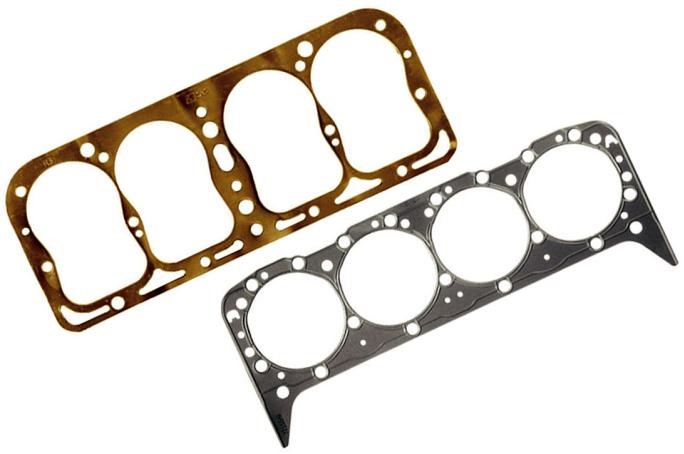Today’s head gaskets have come a long way in design and function over the last five or six decades. The requirements for them have driven these changes and we will look at this evolution to help explain for those who are new to this industry or brush up for those who have been around a long time.
Early Generation Head Gaskets
The early head gasket was often referred to as a sandwich style gasket. They were a fiber-based material that had excellent thermal properties that was sandwiched between to layers of copper or steel and then eyelets were closed around all the coolant and oil openings to keep the fluid from getting to the fiber material within. The combustion openings had metal armors that formed around the top and bottom like an eyelet to contain the combustion process. This gasket style was very soft and conformable to accommodate very loose manufacturing tolerances of the day.
Although many were installed dry, these gaskets were often covered by the installer in a copper coat or some other coating to enhance micro sealing of the surface finishes. One of the early head gaskets was a shim gasket for the small block Chevy. It had embossments like what you see on current MLS head gaskets. The difference is the material back then was a mild steel with no recovery to it. The embosses give a high initial load to seal and then as the head lifts the gasket does not recover with it like it does on later generation MLS gaskets.
Composite Head Gaskets
The next generation head gasket was known as composite, these are a combination of fiber based or graphite-based materials and rigid cores like steels or stainless steels. These materials were also enhanced with coatings and screen-printed sealing beads strategically placed to improve fluid sealing. The combustion pressure was sealed using a wrap around armor to protect the composite material from the higher temps seen at combustion. Let’s look at the details of this generation of head gaskets…
The body of a composite gasket is either a perforated core or a laminated core. The perforated core provided a mechanical attachment of the fiber based or graphite-based facing materials used to seal fluids. These fiber and graphite materials are densified to a pre-determined amount to provide the best sealing capabilities possible. Aftermarket manufactures spent countless hours and money static and dyno testing to prefect this process. Once the material is densified it needs to be blanked out to produce all the bolt holes, combustion opening, fluid metering holes for oil and coolant and the outside contour profile. This is achieved by either simple rule die blanking or steel die blanking process. The important portion of this blanking process is the locations of the dowel pin holes in relation to the combustion openings. If this relationship is not accurate, the combustion openings can be out of position and unload the combustion seal. For composite gaskets, manufacturers utilize an armor to wrap around the body. This material is usually a tin plate or more likely a stainless steel. The material sits on top and bottom of the body material and when compressed it densifies the body material more and creates a high concentrated load to handle the firing pressures. The screen-printed materials are placed in specific areas to seal fluids. This material is usually a silicone or nitrile and like the armor creates a more densified area to increase loading to seal the fluids. The screen-printing is not always needed as the body material is more than capable of sealing fluids but on certain applications the beads are a benefit. The last part of a composite gasket is the coating. The head gasket is usually coated on both sides to serve two functions.
One is to provide a micro seal that helps fill in the tiny peaks and valleys of the surface finishes on the flanges. The other is to provide a release agent for disassembly. The coatings can be formulations of Silicone, Moly or Teflon. These constructions served the industries very well for decades, but the modern engine designs and function evolved to a point where these gaskets could no longer perform to those demands. This led to the next generation of head gaskets.
By Brian Roberts. Read the full story here:



